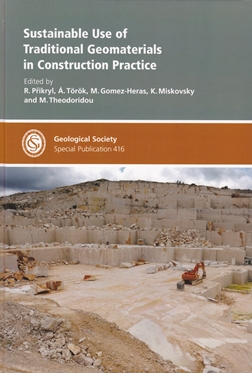 This special publication by the Geological Society of London presents 22 original research papers in the field of geomaterials used in construction. The research papers are grouped in four sections and discuss sustainability issues, sources and performance of local natural stone, properties and durability of natural stone and aggregates, and weathering and conservation of geomaterials.
This special publication by the Geological Society of London presents 22 original research papers in the field of geomaterials used in construction. The research papers are grouped in four sections and discuss sustainability issues, sources and performance of local natural stone, properties and durability of natural stone and aggregates, and weathering and conservation of geomaterials.
The extraction and use of inorganic raw materials derived from the Earth’s crust, termed ‘geomaterials’ in this special publication, have been the main features that distinguish modern man from his man-ape ancestors. The concept of sustainable use of raw materials is discussed, encompassing the reduced extraction of primary resources and the employment of technologies and maintenance strategies to produce less harmful substances and minimise impact on the environment.
The research papers refer to traditional geomaterials and their use in construction in Italy, Germany, Austria, Portugal, Spain, France, Turkey, Cyprus, Netherlands, Egypt, Hungary and Greece. The geomaterials presented include a variety of lithologies such as marble, limestone, chalk, sandstone, breccia, conglomerate, granite, tuff, gneiss.
Most of the research papers are written by geologists. However, the plethora of information presented on availability, accessibility, workability, durability, serviceability and sustainability of the geomaterials will also be of interest to those working in the civil engineering industry, especially architecture and landscape engineering, as well as cultural heritage and monument conservation professionals.
In the context of the sustainable use of geomaterials, innovative methodologies are presented in detail along with the more widespread concepts of recycling and down-cycling; to name a few of the innovative methodologies discussed: employment of micro-destructive techniques in the characterisation of monumental stone, potential applications of residual sludge from dimension-stone working plants, use of nano-composites for stone protection and monument and historical buildings protection, GIS database techniques to establish stone replacement strategies. Examples of the successful employment of these innovative methodologies are presented.
The detailed study of geomaterials physical and mechanical characteristics, together with an understanding of their geological origin, environmental context and mode of use, are emphasized as key factors for the application of effective conservation and rehabilitation actions and their overall sustainable use.
This special publication by the Geological Society of London is a comprehensive contribution in the field of geomaterials used in construction, enriched with high quality graphs, location maps, data-tables and schematic diagrams. It is a recommended read and reference work on the sustainable use of geomaterials in the construction industry both for specialists and non-specialists.
Reviewed by Christos Botsialas
SUSTAINABLE USE OF TRADITIONAL GEOMATERIALS IN CONSTRUCTION PRACTICE by R PRIKRYL, A TOROK, M GOMEZ-HERAS, K MISKOVSKY & M THEODORIDOU (Editors), 2016. Published by the Geological Society of London, Special Publication 416, 311pp (hbk) ISBN:9781862397255 List Price: £120; Fellows: £60. W: www.geolsoc.org.uk/SP416